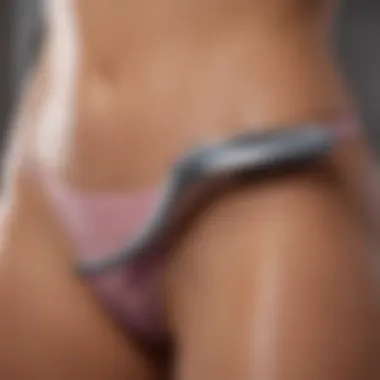How to Use a Bikini Razor: Your Ultimate Guide


Intro
Using a bikini razor is essential for personal grooming, especially for those who want to maintain a clean and polished appearance. The goal is not only to be aesthetically pleasing but also to promote comfort in sensitive areas. Shaving can sometimes cause skin irritation, ingrown hairs, and discomfort. This guide will offer practical steps on how to effectively use a bikini razor while minimizing these issues.
In this article, we will discuss preparation methods, shaving techniques, post-shave care, and maintenance of your bikini razor. Understanding these aspects will help individuals achieve a positive grooming experience.
"Preparation is key for an effective and comfortable shave."
By following the detailed instructions, one can master the shaving process and enhance their personal grooming routine.
Wellness
Maintaining skin health during shaving is crucial. Skin irritation can arise from various sources including the razor itself, the environment, or even skin conditions. Following good practices not only improves physical health but can also have a positive impact on mental well-being.
Physical Health
When using a bikini razor, it is imperative to focus on skin health. Before shaving, exfoliate the area to remove dead skin cells. This reduces the likelihood of ingrown hairs. Choose razors specifically designed for delicate areas. For example, Schick Hydro Silk Sensitive Care is a tool crafted with a moisturizing element to prevent irritation.
Mental Health
A well-groomed appearance can enhance confidence levels substantially. Taking time for self-care can lead to a more positive self-image. Engaging in personal grooming rituals promotes mindfulness, thus supporting one's mental health.
Nutrition and Diet
While not directly related to shaving, a healthy diet can improve your skin’s overall appearance. Foods rich in vitamins and antioxidants, such as berries and leafy greens, promote skin health, which may lead to better results during shaving. Stay hydrated as well; drinking enough water helps maintain skin elasticity.
Fitness and Exercise
Regular exercise induces better blood circulation, which can benefit skin health as well. Additionally, being physically active can also reduce stress, contributing to a lower likelihood of skin problems during grooming.
Techniques for Effective Shaving
Preparing for a shave is critical. Proper technique can not only ensure a smoother shave but also minimize the risk of cuts and bumps.
Steps for Shaving with a Bikini Razor
- Clean the Area: Always cleanse the skin with a gentle soap or body wash. This prepares the skin for shaving.
- Exfoliate: Use a scrub or exfoliant to remove dead skin cells. This will help prevent ingrown hairs.
- Apply Shaving Gel or Cream: Use a product that is suitable for sensitive skin, as it helps to soften hair and provide a barrier.
- Shave Carefully: Use short, gentle strokes in the direction of hair growth. Avoid pressing hard on the razor to reduce irritation.
- Rinse the Razor Often: Keep the razor clean to enhance its efficiency and reduce the risk of infections.
- Aftercare: After shaving, rinse with cool water and pat dry. Apply a soothing lotion or aloe vera gel to calm the skin.
Following these steps will ensure a better experience, leading to satisfactory results.
Aftercare and Maintenance
Post-shave care is equally important. Proper aftercare can help prevent irritation and inflammation of the skin. Use products like creams and gels that have soothing ingredients, such as tea tree oil or chamomile, to calm the skin.
Regularly clean your bikini razor, as bacteria can build up, leading to infections. Store it in a dry place and replace your razor regularly, ideally every 5 to 7 uses, to ensure a safe shaving experience.
By adhering to these guidelines, individuals can significantly enhance their personal grooming practices, achieving not only physical comfort but also a mental boost.
Understanding the Bikini Razor


The significance of understanding a bikini razor extends beyond merely achieving a clean shave. It involves comprehending the unique design and purpose of the tool, which is specifically aimed at sensitive areas. Bikini razors are not just another shaving tool; they possess distinctive features tailored for delicate skin, making them an essential element of personal grooming for many. Recognizing their utility can help individuals choose the right tools, reduce the risk of irritation, and enhance the overall shaving experience.
In this guide, we will delve into various aspects of the bikini razor, equipping you with the knowledge necessary to optimize your grooming routine. By examining the structure and functionality of these razors, we aim to reinforce the importance of informed choices in personal care. The reader will gain insights into how to use the razor effectively, as well as the key differences between bikini razors and standard razors.
What is a Bikini Razor?
A bikini razor is a specialized shaving tool designed for grooming the bikini area. These razors typically feature a compact and lightweight design, allowing for easy maneuverability around the contours of the body. The blades are often shielded to prevent cuts and nicks, which is a common concern when shaving sensitive regions. Additionally, many bikini razors include features such as moisturizing strips or ergonomic handles, enhancing both comfort and effectiveness during the shaving process.
Utilizing a bikini razor can be particularly beneficial due to its focus on safety and precision. Whether you are preparing for a swim, vacation, or simply prefer a neater appearance, understanding how to use this tool correctly can lead to a smoother and more satisfying outcome.
Differences Between Bikini Razors and Other Razors
Bikini razors differentiate themselves from standard razors through various characteristics. First, the blade design often includes guards or safety features that specifically aim to protect delicate skin from cuts. Standard razors, on the other hand, may not have these safety elements, making them less suitable for sensitive areas.
Another distinction lies in the blade count. Bikini razors generally have fewer blades compared to multi-blade razors, as this reduces the risk of irritation while still providing an effective shave. Moreover, the size and shape of bikini razors are compact, making them easier to handle and control in tight spaces.
In summary, understanding these differences allows an individual to make better decisions regarding personal grooming. Individuals should consider their unique preferences and skin sensitivity when choosing between a bikini razor and other types of razors. This awareness contributes to a more effective grooming routine, ultimately enhancing the overall experience.
Preparation for Using a Bikini Razor
Preparation is a vital step in using a bikini razor. Effective preparation can minimize the risk of skin irritation and enhance the overall shaving experience. It involves several components, such as selecting the right razor, gathering necessary supplies, and understanding your skin type. When preparations are undertaken properly, it leads to a smoother shaving process with better results. This section highlights the importance of preparation in achieving a comfortable and effective grooming routine for sensitive areas.
Choosing the Right Razor
Selecting the right bikini razor is essential for achieving optimal results. A good bikini razor should be designed specifically for sensitive skin and areas. Unlike standard razors, bikini razors often have features that cater to the challenges of shaving delicate areas. They may come with safety guards or rounded edges to reduce the likelihood of cuts and nicks. A well-designed razor helps in providing a smooth shave without causing unnecessary irritation or discomfort. Therefore, it is prudent to look for a razor that suits your personal grooming needs and preferences.
Gathering Necessary Supplies
Shaving cream or gel
Shaving cream or gel is an important element when using a bikini razor. These products create a protective barrier between the razor and your skin. They help in softening the hair and lubricating the skin, which assists in reducing friction during the shave. The right shaving cream or gel can significantly enhance comfort and minimize the risk of irritation. Popular choices are often those that contain soothing ingredients like aloe vera or chamomile. However, some products can cause allergic reactions, so it is best to do a patch test prior to application.
Towels
Towels play a practical role in the grooming process. They are used to dry the area before and after shaving, reducing the risk of irritation or infection. A clean towel provides a hygienic surface to work with and ensures that your skin is free of any moisture or product residue. It is wise to keep a dedicated towel for shaving to avoid transferring bacteria from other surfaces. Soft, absorbent towels are better choices as they are gentle on the skin during the drying process.
Post-shave moisturizing lotion
Using a post-shave moisturizing lotion is crucial for caring for the skin after shaving. This lotion hydrates the skin, helping to calm any irritation that might result from the shave. Ingredients like shea butter or vitamin E are valuable in a post-shave lotion, as they nourish the skin and promote healing. Adequate aftercare can prevent dryness and redness, which may occur after shaving. Always choose a lotion that is fragrance-free and suitable for sensitive skin to avoid potential allergic reactions.
Shaving Techniques
In this section, we emphasize the vital role of shaving techniques when it comes to bikini area grooming. The bikini area is delicate and sensitive, making it crucial to adopt proper methods to prevent irritation or discomfort. Effective shaving techniques not only ensure a clean shave but also promote skin health. Knowing how to navigate the contours of the bikini line with precision minimizes the risk of nicks and cuts. Additionally, using the right technique can enhance the overall shaving experience, making it smoother and more efficient.
Best Practices for Bikini Area Shaving
To achieve optimal results while shaving the bikini area, several best practices should be followed:
- Exfoliate Before Shaving: Exfoliation removes dead skin cells, which can cause ingrown hairs. Use a gentle scrub or exfoliating mitt a day before shaving.
- Use a Sharp Razor: A dull blade can lead to more irritation and cuts. Ensure your bikini razor is sharp and in good condition.
- Apply Shaving Cream or Gel: A quality cream or gel creates a protective barrier and helps the razor glide smoothly over the skin, reducing the risk of irritation.
- Shave in the Right Direction: Shave in the direction of hair growth to minimize tugging. This reduces redness and irritation post-shave.
- Rinse the Blade Frequently: Regular rinsing removes hair and shaving cream buildup, maintaining the razor’s effectiveness.
Step-by-Step Shaving Process


A systematic approach will help achieve the best results when shaving the bikini area. Follow these steps for a great experience:
- Prepare the Area: Begin by ensuring the area is clean. A warm shower can help soften the hair and open pores.
- Exfoliate: Use an exfoliant gently. This helps prevent ingrown hairs.
- Apply Shaving Cream: Choose a shaving cream designed for sensitive skin. Distribute it evenly over the bikini line.
- Position Yourself: Find a comfortable position that offers good visibility and control. Using a mirror can help.
- Begin Shaving: Start with light strokes, moving with the direction of hair growth. Do not apply too much pressure to avoid cuts.
- Rinse and Wipe: Frequently rinse the blade and wipe away excess cream and hair.
- Finish Up: Once done, rinse the area with cool water to soothe the skin. Pat dry gently with a towel.
Common Mistakes to Avoid
While shaving the bikini area, certain mistakes can lead to a frustrating experience or skin issues. Here are some to watch out for:
- Skipping Exfoliation: Failing to exfoliate increases the chance of ingrown hairs.
- Using a Dull Razor: This makes it harder to get a clean shave and increases irritation risk.
- Shaving Dry Skin: Not using a cream can lead to cuts and razor burn.
- Rushing the Process: Being careless can result in mistakes, like missed spots or cuts. Take your time.
- Ignoring Post-Shave Care: Neglecting to moisturize afterwards can leave skin dry and irritated.
Always prioritize care and quality when shaving the bikini area to ensure comfort and precision. This can greatly enhance the overall grooming experience.
Post-Shaving Care
Post-shaving care is crucial for achieving smooth skin and preventing complications that can arise following the shaving process. The sensitive nature of the bikini area warrants effective post-care strategies to minimize irritation and promote skin health. By understanding and implementing proper aftercare practices, you can ensure a more satisfying grooming experience and maintain the skin's integrity.
Cleaning the Shaved Area
After shaving, it is important to clean the shaved area gently. This helps remove any remaining shaving cream, hair, or skin cells that may have accumulated during the shaving process. Use lukewarm water to rinse the area. Avoid using hot water, as it can irritate sensitive skin. A mild, unscented soap can be beneficial. Apply it delicately, ensuring to avoid any rough scrubbing.
An extra tip: pat the skin dry with a soft towel instead of rubbing it. This reduces chances of friction, which can lead to discomfort or irritation. Cleanliness ensures that any post-shaving products can be applied effectively, aiding in recovery.
Moisturizing and Soothing the Skin
Moisturizing the shaved area is essential for replenishing hydration and soothing any inflammation. Use a gentle, fragrance-free moisturizer or an aloe vera gel. Both options are effective in calming the skin and providing moisture. Applying this product after cleaning not only helps in preventing dryness but also promotes healing.
It is also wise to avoid products with strong fragrances or harsh ingredients as they may exacerbate irritation. Instead, look for those labeled as hypoallergenic or formulated for sensitive skin types.
Identifying and Managing Irritation
It is normal for some individuals to experience mild irritation, such as redness or a slight burning sensation, after shaving. Pay attention to your skin's reaction. If persistent irritation occurs, consider the following:
- Change Your Razor: Dull blades can lead to more irritation. Ensure that your bikini razor is sharp and in good condition.
- Review Your Technique: Evaluate your shaving method. Are you applying too much pressure or shaving against the grain? Adjusting these factors can minimize discomfort.
- Spot Treatment: If you notice bumps or severe irritation, applying a topical cream containing hydrocortisone may help. However, for serious issues, consulting a dermatologist is advised.
By addressing post-shaving irritation promptly, you can reduce discomfort and avoid long-term effects. Remember, proper aftercare is just as significant as the shaving technique itself.
Razor Maintenance and Care
Razor maintenance and care is a crucial aspect of achieving a comfortable and effective shaving experience, particularly when it comes to bikini razors. Proper care extends the life of your razor, enhances its performance, and minimizes the risk of skin irritation. By adopting good maintenance habits, you ensure that your shaving tool continues to provide a clean and smooth shave, maximizing hygiene and effectiveness.
Proper Cleaning Techniques for Your Razor
Cleaning your bikini razor after each use is essential. When hair, shaving cream, and bacteria accumulate on the blade, it can lead to a less effective shave and increased skin irritation. Here are steps for proper cleaning:
- Rinse Immediately: After shaving, rinse the razor under warm water to remove any hair or cream residue. Make sure to rinse both sides of the blade.
- Use a Brush: Occasionally, use a toothbrush or a similar soft brush to gently scrub the blades. This helps remove any build-up that may not come off with rinsing alone.
- Dry Carefully: After rinsing and cleaning, shake off excess water and gently pat the razor dry with a towel. Avoid wiping the blade, as this can cause dullness or damage.
- Store Safely: Keep your razor in a dry area to prevent rust. Avoid leaving it in the shower or a damp place where moisture can accumulate.
By regularly cleaning your bikini razor, you maintain its sharpness and reduce the risk of infection caused by bacteria. A clean blade is not only more effective but also safer for your skin.
When to Replace Your Razor Blade
Understanding when to replace your razor blade is key to achieving optimal shaving results. Wearing down blades can lead to nicks, cuts, and skin irritation. Here are some signs that indicate it's time for a replacement:


- Deterioration in Performance: If you find that you are having to pass over the same area multiple times to achieve a smooth shave, it may be time to replace the blade.
- Visible Damage: Inspect the blades regularly for any visible signs of rust, nicks, or bluntness. If the blade appears worn, it's best to change it.
- Foul Smell: If you notice any unusual smell coming from the blade or razor, it indicates that bacteria could be present, suggesting a change is necessary.
- Frequent Ingrown Hairs: Increased occurrences of ingrown hairs can signal that your blade is no longer effectively cutting hair at the proper angle, leading to skin irritation.
Typically, for the bikini area, it is advisable to replace the blade every 5-10 shaves, depending on the hair thickness and shaving frequency.
Keeping track of your blade's condition helps you maintain a comfortable and effective shaving routine. With the right approach to razor maintenance, you can ensure a positive experience and promote healthier skin.
Alternative Hair Removal Methods
In addition to using a bikini razor, there are other hair removal methods that individuals may consider. Each option has its own set of advantages and disadvantages. Understanding these methods can aid in making informed choices about personal grooming. Evaluating alternatives ensures that individuals find the most suitable method for their skin type and hair growth. Moreover, this comparison highlights the importance of choosing the right hair removal technique based on individual comfort, effectiveness, and desired results.
Comparison with Waxing
Waxing is a popular alternative to using a bikini razor. The process involves applying hot or cold wax to the skin and then removing it quickly, pulling hair from the roots.
Benefits of Waxing
- Long Lasting Results: Waxing can keep the area hair-free for several weeks due to the hair being removed from the root.
- Finer Regrowth: Hair often grows back softer and finer compared to shaving.
- Less Frequent Maintenance: Depending on individual hair growth, sessions can be spaced out more, allowing less frequent visits to a salon or less self-treatment at home.
Considerations
- Pain Sensitivity: The process can be painful, especially for first-time users or those with sensitive skin.
- Skin Reactions: Some individuals may experience redness or irritation post-wax. It's advisable to perform a patch test to ascertain skin reaction.
- Preparation Needed: There is a need for hair to grow to a certain length before waxing, which may not be convenient for some users.
Waxing can be a great choice for those looking for longer-lasting hair removal; however, the discomfort may deter users who prefer a less-invasive technique.
Exploring Laser Hair Removal
Laser hair removal is another alternative that has gained popularity in recent years. It involves using concentrated light beams to damage hair follicles, resulting in reduced hair growth.
Benefits of Laser Hair Removal
- Permanent Reduction: Many users experience a significant reduction in hair regrowth after several sessions.
- Precision: Lasers can selectively target dark, coarse hairs without harming surrounding skin.
- Time Efficient: Each session generally takes less time than traditional methods, allowing for quick treatment even in sensitive areas.
Considerations
- Cost: Laser hair removal is typically more expensive than traditional methods and may require multiple sessions for optimal results.
- Skin Type Limitations: Not all skin tones and hair colors are suitable for laser treatment. Consultations are advised.
- Possible Side Effects: Temporary redness or swelling can occur post-treatment. Users should understand these potential reactions.
Laser hair removal provides a long-term solution for hair reduction. For those willing to invest in the procedure, it can be a practical method that eliminates the need for regular shaving or waxing.
Closure
In this article, we have explored the multifaceted realm of using a bikini razor, emphasizing its necessity for personal grooming in sensitive areas. Understanding the product and practicing safe techniques can deeply enhance your shaving experience. Precautions should not be overlooked, as they play a vital role in minimizing skin irritation, which happens often in delicate regions.
Recap of Key Points
To crystallize the insights shared throughout the article:
- Understanding the Bikini Razor: Grasp its unique design tailored for sensitive areas compared to other razors.
- Preparation: Selecting the right razor and essential supplies helps pave the way for a smoother shaving process.
- Shaving Techniques: Mastering the techniques can alleviate common blunders and lead to better results.
- Post-Shaving Care: Proper aftercare is crucial for maintaining skin health and comfort.
- Razor Maintenance: Regular cleaning and timely blade replacements foster longer-lasting and safer grooming implements.
- Alternative Methods: Considering methods like waxing and laser treatments may offer insights into different grooming choices.
Each of these components contributes to a comprehensive understanding of using a bikini razor effectively.
Encouragement for Safe Practices
Prioritizing safety during the shaving process is not just about achieving aesthetic results but also about protecting skin integrity. Encourage best practices:
- Always use shaving cream or gel to create a protective barrier.
- Take your time when navigating curves and edges to reduce mishaps.
- Regularly check for any signs of irritation or allergic reactions post-shaving.
"A calm and careful approach can significantly enhance your grooming experience while minimizing complications."



